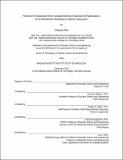Prediction of departure from nucleate boiling in subchannel applications : from mechanistic modeling to hybrid framework
Author(s)
Zhao, Xingang,Ph.D.Massachusetts Institute of Technology.
Download1200116645-MIT.pdf (11.08Mb)
Other Contributors
Massachusetts Institute of Technology. Department of Nuclear Science and Engineering.
Advisor
Koroush Shirvan and Robert K. Salko.
Terms of use
Metadata
Show full item recordAbstract
The critical heat flux (CHF) corresponding to the departure from nucleate boiling (DNB) is a regulatory limit for licensing of pressurized water reactors (PWRs). Under DNB conditions, the heated surface is blanketed by a stable vapor film, leading to a sharp deterioration of the heat transfer coefficient at the heater/coolant interface and an abrupt temperature rise. Despite the abundance of predictive tools available to the reactor thermal-hydraulics community, the path for an accurate, robust CHF model remains elusive due to lack of consensus on the DNB triggering mechanism. In this thesis, a comprehensive study of physics- and data-driven DNB modeling approaches is presented with the objective of achieving superior predictive capabilities in subchannel applications. In a rod bundle where the coolant region is modeled as an inter-connected array of subchannels, the local boundary conditions are determined through the use of subchannel codes, such as CTF in this work. As an essential prerequisite step to determine code readiness, the single- and two-phase capabilities of CTF are assessed by comparing against targeted experiments and the commercial subchannel code VIPRE-01 on flow distribution, pressure drop, and void content. The key two-phase closures in CTF that are in the greatest need of improvement are identified and discussed, including subcooled boiling heat transfer and liquid-vapor interfacial friction. Then, existing macro-scale physics-driven CHF models are surveyed. In view of their limitations, an evolutionary mechanistic model is proposed, leveraging key assumptions in the relatively well-accepted mechanisms of liquid sublayer dryout and near-wall bubble crowding. Detailed validation and global sensitivity analysis of the proposed model demonstrate its improved accuracy and robustness over currently well-used predictive tools with regard to an extensive database that covers a broad range of geometric and flow conditions. In addition to rod bundles, tube and annulus heaters are also included in the test matrix for their higher data availability and for the similarity of their flow channels to bundle subchannels. Meanwhile, an updated mechanistic model is proposed for use in transient studies where traditional quasi-steady-state approaches would yield significant conservatism. Such a transient DNB model relies on the mechanism established under steady-state scenarios and evaluates the depletion of the presumed liquid sublayer. The model is validated against three sets of power transient experiments, showing close agreement with measurements under conditions of practical interest for a PWR. Lastly, with a fresh perspective from machine learning (ML), the prediction of DNB is approached through a physics-informed ML-aided parallel framework. Such a first-of-a-kind hybrid framework takes advantage of established understanding in the field (i.e., domain knowledge) and uses ML to capture the undiscovered information from the mismatch between experimental and domain knowledge-predicted output. A comprehensive evaluation is carried out to demonstrate the proposed hybrid approach's superior performance over conventional domain knowledge-based models and standalone ML methods for both interpolation and extrapolation purposes. It is shown to readily extend its applicability domain and model complexity on the fly, resulting in an elevated level of flexibility and robustness. In the light of the hybrid framework's promising potential, the concept of window-type extrapolation mapping is further proposed to help inform future high-cost measurement focuses.
Description
This electronic version was submitted by the student author. The certified thesis is available in the Institute Archives and Special Collections. Thesis: Ph. D., Massachusetts Institute of Technology, Department of Nuclear Science and Engineering, 2019 Cataloged from student-submitted PDF of thesis. Includes bibliographical references (pages 150-159).
Date issued
2019Department
Massachusetts Institute of Technology. Department of Nuclear Science and EngineeringPublisher
Massachusetts Institute of Technology
Keywords
Nuclear Science and Engineering.